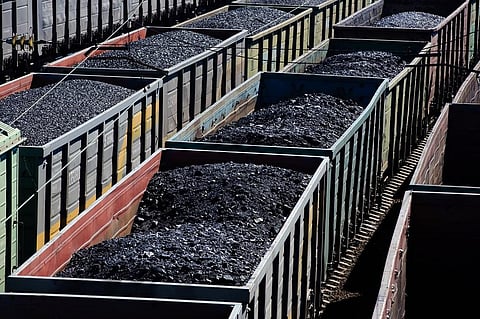

Coal production for the next financial year (2023-24) is estimated to increase to 911 million tonnes, about 17 per cent higher than the previous year, according to the Economic Survey 2022-2023.
Well-timed measures have placed India in a better position to cater to excess energy demand, noted the annual survey, unveiled by finance minister Nirmala Sitharaman on January 31, 2023.
Between April and December 2022, coal production rose by 14 per cent on a year-to-year basis and was 21 per cent higher than in the pre-pandemic financial year of 2019-2020, the survey noted.
The coal industry is expected to grow at 6-7 per cent annually to reach a production level of one billion tonnes by 2025-2026 and about 1.5 billion tonnes by 2030.
This annual growth is consistent with efforts by the government to improve domestic coal production, reduce imports and increase exports.
In March 2022, coal availability was a challenge due to the increasing demand for power across the country, both owing to heatwaves through May 2022 as well as a sudden increase in economic activity after the post-pandemic slumber.
Moreover, to protect the economy from the rising international coal prices, the power sector curtailed coal imports drastically from 69 million tonnes (MT) in 2019-2020 to 45 MT in 2020-2021 and further to 27 MT in 2021-2022.
However, domestic coal production could not match the power demand, having an impact on the coal stock on hold. “Resultantly, in April 2022, even as coal offtake rose to meet higher demand, coal stock with power plants, as on April 31, 2022, fell to 8 days from 12 days a year ago,” the document read.
Nevertheless, the Centre took several urgent measures to improve the current coal stock. As of December 30, 2022, the coal stock at power plants stood at “12 days compared to 10 days on June 30, 2022 and 8 days a year ago”. Simultaneously, the capacity utilisation of thermal power plants went from about 80 per cent to above 90 per cent.
The survey listed the measures taken between April and May of 2022 to address the supply constraints of coal. All power generators were told to import 10 per cent of their coal requirement, up from four per cent earlier.
Penalties, such as the curtailment of domestic coal entitlements, were announced if power plants failed to import coal. Under Section 11 of the Electricity Act 2003 (Act), the government directed imported coal-fired thermal power plants to run at full capacity. They were assured of compensation for enhanced costs.
Generally, coal mines rely on the railways to transport coal, but tolling was enabled, which allowed states to transfer their allotted coal to private generators near the mines.
Lastly, Rural Electrification Corporation / Power Finance Corporation and commercial banks were advised to facilitate the availability of additional working capital to power generating plants.
The table reflects the annual investment in the renewable energy sector in India
Investment in the renewable energy sector was $78.1 billion in India during 2014 -2021. “Investment in renewable energy has been close to or higher than $ 10 billion per year since 2016, except for a dip in 2020, likely due to various Covid-19 restrictions,” the survey noted.
The Pradhan Mantri Ujjwala Yojana, launched in 2016 to promote clean cooking fuel, was expanded under the Union Budget 2021-2022.
Ujjwala 2.0 offered deposit-free LPG connections with a first free fill, without a loan against their hot plate, to beneficiaries. Under this scheme, 16 million connections have been released until November 24, 2022, the report claimed.
Between 2020-2021 and 2021-2022, there was a sharp increase in the freight traffic i.e., transport of goods, in the Indian Railways (IR), reflecting the strong revival of domestic economic activity, the report stated.
During 2022-2023 (up to November 2022), IR carried 976.8 million tonnes of revenue-earning freight traffic (excluding Konkan Railways Company Limited), as against 901.7 million tonnes during the corresponding period in 2021-2022, which translated into an increase of 8.3 per cent, the survey noted.
The total capital expenditure on the IR increased to Rs 99,178 crore between 2014-19 from Rs 45,000 crore between 2009-2014. Furthermore, capital expenditure increased to Rs 2,45,800 between 2022-2023 from Rs 1,48,064 crore between 2019-2020.
The Ministry of Railways plans to achieve 100 per cent electrification of its fleet by December 2023. Between 2014-2022, 30,446 Route Kilometres (RKM) have been electrified, a six-fold increase from the previous eight years of electrification achieved at 4,698 RKM.
Read more: